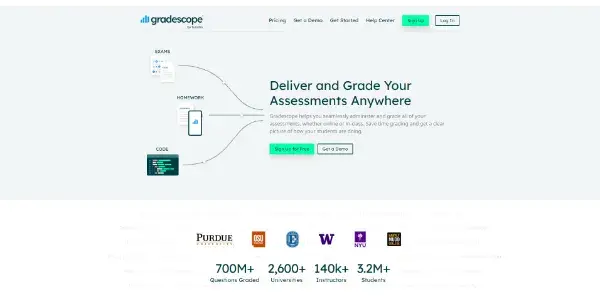Gradescope

Manage and mark all your tests, MCQs and exams efficiently, in class or online. Compatible with a wide range of school subjects
Gradescope: Streamlining Assessment and Grading for Educators
Gradescope is a powerful AI-assisted tool designed to simplify and expedite the process of grading assessments, including tests, multiple-choice questions (MCQs), and exams, both in-class and online. Its compatibility spans a wide range of school subjects, making it a versatile solution for educators across various disciplines. This article delves into its functionality, benefits, applications, and how it stacks up against competitors.
What Gradescope Does
Gradescope fundamentally transforms how educators manage and assess student work. It automates many tedious aspects of grading, allowing instructors to focus more on providing feedback and less on the mechanics of scoring. This includes features like automated grading for objective questions, efficient organization of student submissions, and tools to facilitate detailed, timely feedback.
Main Features and Benefits
Automated Grading: Gradescope excels at automatically grading objective questions like MCQs and true/false questions, saving significant time and reducing grading errors. It can also partially automate the grading of subjective assessments, such as essays and coding assignments, by providing structured rubrics and allowing for efficient point allocation.
Efficient Workflow Management: The platform offers a streamlined workflow for managing assignments, collecting submissions, and distributing grades. Its intuitive interface makes it easy to organize large numbers of assignments and student submissions.
Detailed Feedback & Rubrics: Gradescope facilitates comprehensive feedback. Instructors can create custom rubrics to guide grading and provide consistent evaluations. This ensures fairness and enables students to understand the criteria for assessment. Feedback can be both automated (e.g., "Correct answer," "Incorrect answer with explanation") and manually entered.
Improved Efficiency & Speed: By automating portions of the grading process, Gradescope dramatically reduces grading time, allowing instructors to spend more time on other crucial tasks, such as lesson planning, student interaction, and curriculum development.
Data Analytics & Insights: The platform provides data-driven insights into student performance, enabling educators to identify areas where students struggle and tailor their teaching accordingly. This data can inform future lesson planning and curriculum adjustments.
Collaboration Features: Gradescope supports collaboration among graders (e.g., TAs). Multiple graders can work on the same assignment, ensuring consistency and reducing workload.
Use Cases and Applications
Gradescope's applications are diverse and cater to various educational settings:
K-12 Education: Automating MCQ grading in large classrooms, providing detailed feedback on essay assignments, and tracking student progress throughout the year.
Higher Education: Streamlining grading for large lecture courses, grading programming assignments using automated code checks, and managing peer reviews.
Online Learning Platforms: Integrating with existing learning management systems (LMS) to manage assignments and provide automated feedback in online courses.
Comparison to Similar Tools
Gradescope competes with other assessment platforms, such as Gradescope itself (there seems to be some confusion in the prompt regarding a single tool named "Gradescope AI"), but its strength lies in its robust automated grading capabilities and user-friendly interface. While other tools may offer similar features, Gradescope often stands out in terms of ease of use and the comprehensiveness of its feedback mechanisms. A direct comparison requires specifying alternative tools; however, Gradescope typically focuses on providing a more integrated and efficient grading workflow.
Pricing Information
Gradescope operates on a freemium model. This means a basic version of the platform is available for free, offering limited features suitable for smaller classes. Paid plans, which provide access to more advanced features such as increased storage, support for larger classes, and enhanced analytics, are available at different price points depending on the needs of the institution or individual educator. Specific pricing details are usually available on the Gradescope website.